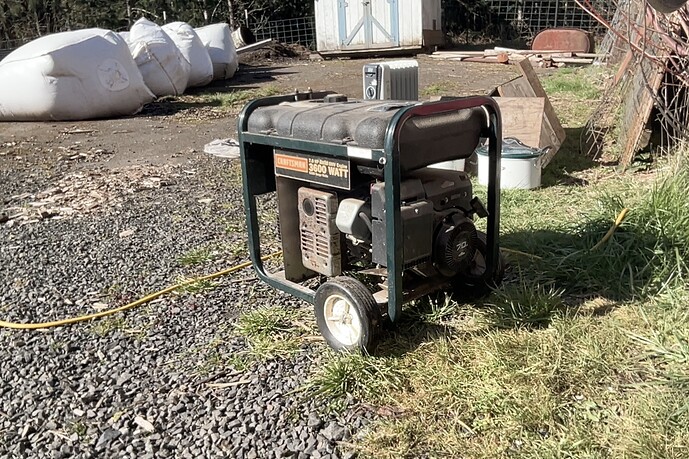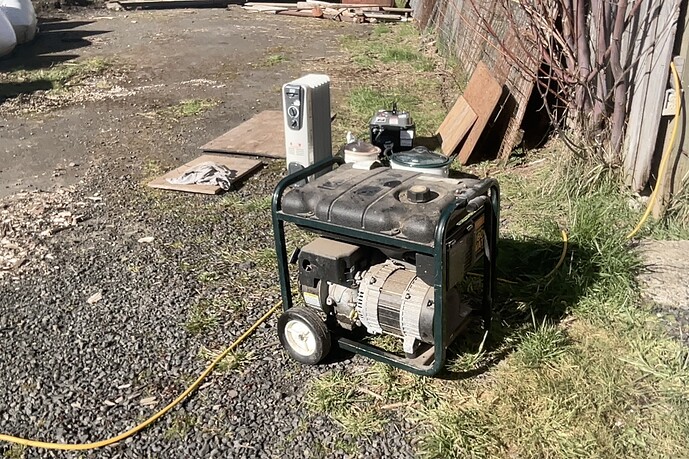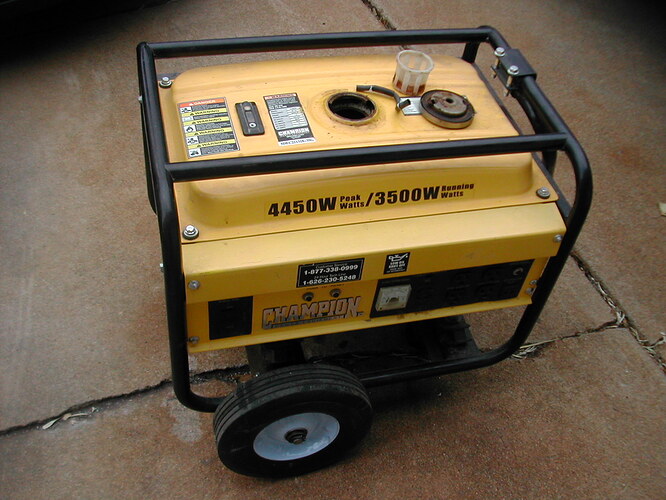Are you still just experimenting or do you think you need the extra power by adding wood? I think it is pretty well established that small engines are the safest with a diet of charcoal.
All of the above. I’m mostly trying to get as much of ‘the other 75%’ as I can before I move on to the next phase. But of course who wouldn’t want more power? And 1.2KW out of a 3KW generator doesn’t seem like much. Kristijan talked about “rocket fuel”. I estimate that I have a 4 inch layer of ash and char surrounding the reaction zone. I thought that that much insulation might hold in the heat a little better allow this setup to do a some things others don’t. You never know if you don’t try.
Rindert
rindert,how much dust you catch with the socks normally? have you a picture of throttle and spark plug after some hours of running time?
with a cage instead of tube with holes would be possible to achieve more active filter surface and getting a breathing filter, but to whom i tell this…
I don’t take it apart unnecessarily because it always starts and runs perfectly.
Yes I have thought about this, but this filter is working very well. I have seen a filter for milk that used a spring instead of a tube. It also worked very well.
Rindert
yes, i understand, the throttle block on briggs engines is to remove a bit difficult, also the spark plug…i asked because my experience with dry foam filters - easy system -was not so good, because fine dust goes through after a while…therefore i work with wet filters now, but this is more complex…the simplicity of some socks would be hard to beat if they are able to hold also the finer dust in dry filtering method.
more working hours , continous runs shows us how good is the filtering… if the filter is less good, with a while layers of dust accumulate on the throttle and can block it, and the spark plug gets also dirty, from my experience…maybee this is not to see when starting and end of running is with gasoline, because maybee it cleans all away, but than real working conditions of the filter are not clear…
trust is good, control is better …
Thinking about how to get more power out of my 1978 L-Head Briggs. I’ve been reading about it. It has 6:1 compression. To increase compression I’m thinking about taking the head off to see if I can put a very thin copper or aluminum head gasket in it. I was thinking I could use some spray-on head gasket sealer.
Some time ago I put a more modern magneto with electronic control on it that I thought would advance the ignition timing automatically. It has been working well. But maybe it just can’t advance as far as it would need to for woodgas?
Rindert
1978…so before you do all the hopping-up tricks…what is your static compression pressure? I mean you might benefit from a new piston and rings, or even just a ring cleaning?
Then look at those valves. Make sure they aren’t leaking, and still lifting as high as they are supposed to.
That’s good advice. I’ll do a compression test first. Actually I don’t want to do a lot of ‘hopping-up’. Just looking to actually get 50% of rated power out of it, when on woodgas. So far I have only gotten 40%, and that was on very tarry gas. Yes 1978, but I don’t think it was actually used much, just kept as a standby generator. It outputs the old style square wave. I think that’s the main reason someone sold it to me for $60. Of course I had to solder the filler neck back in and change dry rotted filter and rubber parts.
Rindert
It looks like a I/C version. One thing you could modify besides the engine, is the induction system. That updraft carb setup is pretty restrictive. Seeing as you don’t need a venturi, you could bore out the venturi and install a bigger butterfly.
Talk about the square wave…I didn’t know those could do that.
I never had any luck running flatheads on charcoal , the power loss was terrible for me due to the standard compression ratio being a lot lower than modern engines coming out of china , at some point you have to upgrade to a newer engine or be prepared to really go to town tuning on those old B&S engines , this is of course what i found it may be a different kettle of fish for you guys .
Dave
i use two briggs flathead with 5 hp and 8 hp …me seems very good power( without using full open throttle) for tiller -5hp - and stationary unit for bandsaw and thresher…maybee my coal is stronger because it remains only short time in the heat -twigs are charring very quick- instead thicker pieces stay longer time for charring through, and some destillation gases go more lost in this way?
You are correct Dave.
From the very internal combustion engine beginnings valve-in-block engines (flatheads) were the way to manufacture a four-stroke engine using the least number of parts and machining steps. The less power possible compensated for by going with a larger working displacement.
Anyplace; any application; that valued power-to-weigh or fuel use costs went with overhead valves. More parts. More machining operations. Tricker to lubricate.
My engine life became more valuable when I phased out of all flatheads.
Better yet again phasing out of always needing cleaning and adjusting; with wear, timing drifting, ignition contact points.
Going a step farther to overhead camshafts can give even better in and out flow possibilities. But really only becomes a value if you are pushing for much higher RPM working ranges. Then your service lives shorten from all of the added cam drive parts. You really need superior lubricants. And lubrication systems engineering.
When the flathead engine was direct driving a rotary lawnmower blade; or driving a power belt it was/is easy to convert over to a more better overhead valve engine.
But systems using the engine side case as the power drive end with generator side special crankshaft ends you are screwed for converting upgrading.
Just sell it. Step up to a more modern design. B&S and others have now been making OHV generators for neigh onto 30-40 years now.
Haunt yard, garage sales; and estate sales and you will find these. IMO just pass on the flatheads.
Look at the size and weight of the generator head stack. This system was heavy duty use intended.
Steve Unruh
Another old generator. It runs but the tank is plumb full of nasty. I might just get a plastic tank like the one one on Steve U’s. Anyhoo, $50 so not much worried about anything. I’m a little surprised at the efficiency. Is 92% common for a genhead? I wonder if I’ll get 50% or 2225W out of this one. That would be something good.
Well as long as it has cylinder and valves allow acceptable compression you should be able to make something of it.
A fellow named James Cordon runs a YouTube channel where he buys, repairs then sells these. His evaluation of condition videos are the best.
Here is a part-four video of a Champion 4-stroke that he brought back to life after it broke off and dropped a valve head. Video four he is now working on the applied load governor system to get it to keep making safe to use AC power. Alternative fueling you will want to also monitor closely your on-off electrical loads RPM and therefore frequency:
These RPM synchronous units are all pretty much See-Do mechanically controlled.
I personally have switched over to variable speed engine driven Inverter-Generator units except for the one family gifted to me unit I had pictured. A back up unit for the deep well pump.
Inverter-generator units are mostly electronically controlled. Bumps up your efficiencies and engine life. I am comfortable with my ability to swap, mix, and match the electronics packages on these across manufacturers and wattages.
Regards
Steve Unruh
Here is another James Cordon video showing the hatful of problems you can expect on a given-up on; then sold down cheap modern synchronous engine-generator. Fuel contamination. Clogged carburetors. Previous owner(S) busy fingers mucking up things:
At least skip to ~36 minutes and see just what you can expect from one of these for frequency; voltages; hormonic distortions; and wave forms. Not ever be Big-Grid perfect. Just good enough.
I will say this about these made-in-China units:
When B&S; Kohler; and even Yamaha are choosing one of the PRC mainland manufacturers they have their own engineers evaluate for performance and durability.
Then add in that some marketing brand names like Sears-Craftsman for decades had their own QC/engineers too for their “Best” line tools, appliances and equipments.
What astonished me about the 3600 watt (Sears) Craftsman unit I was family gifted was it did have 230/240 split phase output too. That is rare in small units. More $$$ to make that.
S.U.
depending on the kind of nasty, e85 dissolves a lot of it.
Okay, I can imagine myself getting the tank clean somehow. But what will do with the the stuff I get out of it? At this point the only answer I come up with is putting it in old oil bottles and then in the landfill. Do car washes have means of dealing with this kind of thing?
Rindert
you can burn it or the ethanol just evaporates.
My Champ 3500 has that too. Makes me imagine new capabilities. Like maybe an in induction furnace in which I can melt iron and steel. Now that would be cool!
Also interesting is the 12VDC outlet. 3500/12= 292Amps! I’m doing to have read the manual on this thing.
Rindert
Just watched him fix the governor. I end up thinking I should mount a frequency counter next to the volt meter.
Rindert




